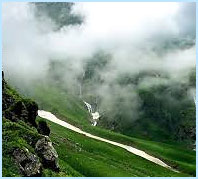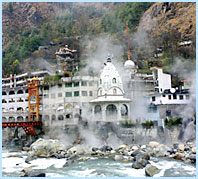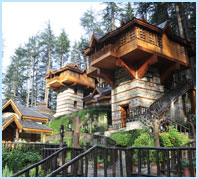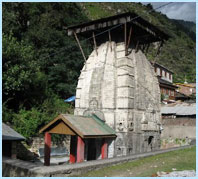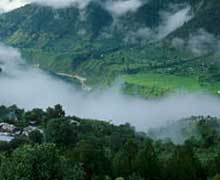- About Kullu
- About Manikaran
- About Kasol
- Images
Place : Kullu, Area: 5,503 sq.kms, Population : 381,571, Altitude : 1230 m (Kullu) Climate : Pleasant temperature in summer and cold below 0 C with heavy snow fall in winter Visiting season: March to June for relaxation and visiting the places of sight seeing and enjoy short and long excursions as well as climbing and river rafting , Languages : Hindi, Punjabi, Pahari, English are understood and spoken by the people engaged in tourism trade
The most charming and beautiful Kullu valley spreads out its charm on either side of river Beas. The valley runs north to south of this river and is 80km long and about 2km at its broadest. Yet with awe inspiring glens and mossy meadows encircled by the rushing streams and meandering brooks, flung east & west, a fairly wide area is open to the tourists, the trekkers, the mountaineers, the artists and to anyone who wishes to escape the heat & dust of the plains to breathe the exhilarating air of the Himalaya and enjoy the spectacle of the variegated mountain scenery. The valley is also famous for its exquisitely woven colourful hand made shawls and kullu caps.
How to reach :
Air : Kullu is connected by Indian Airlines and Air Deccan with Delhi. The airport is at Bhuntar, 10kms. from Kullu.
Rail: Nearest convenient rail heads are Kiratpur and Chandigarh on Broad Gauge and Jogindernagar on Narrow Gauge from where Kullu can be reached by road.
Road : Kulu is well connected by road with Delhi, Ambala, Chandigarh, Shimla, Dehradun, Pathankot, Dharamsala & Dalhousie etc. Regular direct buses ply between these stations including deluxe, semi-deluxe and air conditioned buses during tourist season.
Local transport Local buses operate between Kullu-Manali and Manikaran regularly. Taxis are also available.
Manikaran :
Location : Parvati Valley near Kullu-Manali, Altitude : 1,737m, Houses : Ramchandra temple & Sri Guru Nanak Dev Ji Gurudwara , Famous For: Hot Springs, Famous As a: Hindu & Sikh Pilgrimage
Manikaran is snuggled between the Beas & Parvati River in the Parvati Valley, Kullu District in the state of Himachal Pradesh. Located at an elevation of 1760 m, Manikaran is a famous attraction that holds great religious significance. The region is far-famed for its religious attractions and illustrious hot springs.
History :
Manikaran is a pilgrimage centre that holds great religious profoundly honored by the Hindus. It is believed that “Manu”, the Hindu lawgiver lord made it a sacred place and recreated human life after the flood.
According to another legend, it was here when Lord Shiva and his Devi Parvati were walking in the valley that Goddess Parvati dropped one of her earrings that was seized by the serpent deity Shesha. The serpent only returned the jewel when Lord Shiva performed Tandava and shot the jewel up through water. Seemingly, jewels continued to be thrown up in the waters at Manikaran until the earthquake of 1905.
Attractions
Lord Ramchandra Temple :
Lord Ramchandra Temple was made in the 17th century in honor of Lord Rama by Raja Jagat Singh.
Temple of Lord Shiva :
The Lord Shiva temple is highly revered in Manikaran. It is believed that the devtas of Kullu valley pay visit to this place regularly on specified dates.
Sri Guru Nanak Dev Ji Gurudwara :
The Sri Guru Nanak Dev Ji Gurudwara is one of the most famous religious attractions in Manikaran that is highly honored among people of the Sikh community. As per legends, during third Udasi, Guru Nanak Dev Ji along with his disciple Bhai Mardana came to this place in 15 Asu 1574 Bikrami.
Harinder Mountain :
The Harinder Mountains surrounds the entire region of Manikaran and is a bewitching sight. It is said at a mere look at the mountains frees the onlooker from all evils.
Hot Springs :
The hot springs in the Parvati river is one of the most famous Manikaran attraction that every visitor and tourist. The hot springs is considered holy and it is believed to cure the pain and problem of those who take dip in the springs.
Kulant Pith :
Kulant Pith is the holiest of all piths located in the entire nation. As per legends it is believed that Lord Shiva was very impressed by the beauty of this place and remained here for some time.
How to reach
By Air :
The nearest airport is at Bhuntar Airport is well connected to various destination within as well as outside the state like Delhi, Chandigarh, Pathankot, Dharamshala and Shimla.
By Train :
The nearest railway station is at Pathankot (150 km) and Chandigarh (268 km).
State : Himachal Pradesh,
Temperature : 8°C - 25°C (Summers) 0°C - 11°C (Winters) ,
Altitude : 1720 mts ,
Best Season : Mid-March - mid-April; mid-September - mid-November. May and June could be hot months in this area and December-January are unbearably cold.
The village of Kasol is located on the banks of the Parvati River in Parvati Valley. The village that falls on the way between Bhuntar to Manikaran is snuggled at an elevation of 1640 m. Kasol is zoned into Old Kasol and New Kasol each of which is located on either side of a bride. The entire village is a famous base for Himalayan trekking to SarPass, Pin Parbati Pass, Yanker Pass and Khiriganga. Kasol is highly visited by tourists from Israel and thus one can find numerous banners in Hebrew language throughout the valley.
How to reach :
By Air :
Bhuntar situated 30 km away is the nearest airport to Kasol and is well connected to Shimla, Pathankot and Delhi.
By Rail :
The nearest railway station is at Pathankot (150 km). Chandigarh (310 km) is another railhead to reach Kasol.
By Road :
Various buses both state run and private links Kasol to Kullu, Manali and Chandigarh.
Attractions
The shops of Kasol are the perfect place to buy western clothes and relish some of the most tempting food from the west. Apart from the line of restaurants nearby the Foreign Money Exchange, tourists can also find an ATM in Kasol.
Activities
• Trekking
Images
